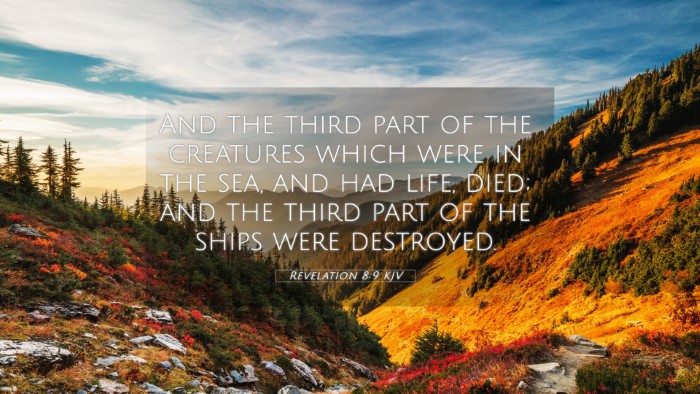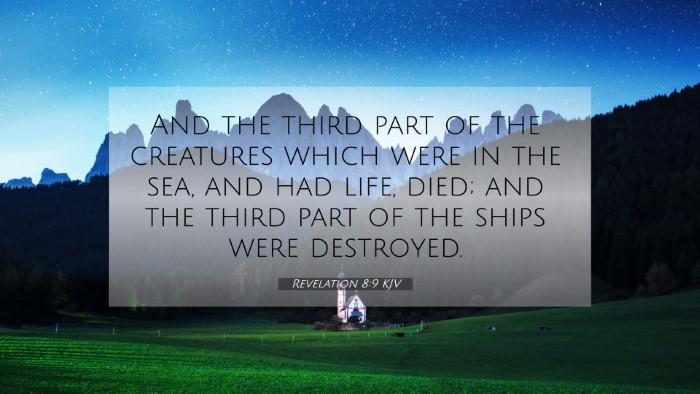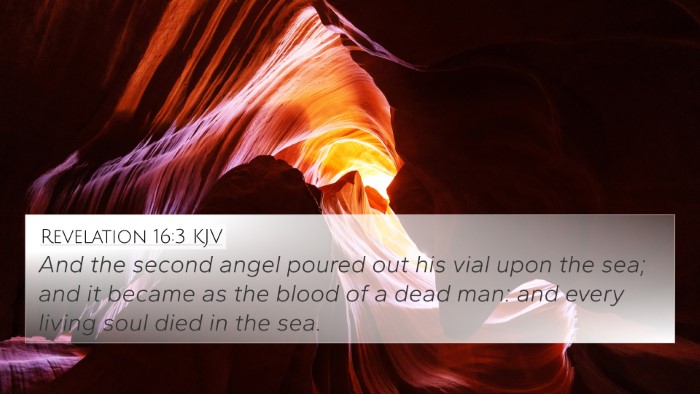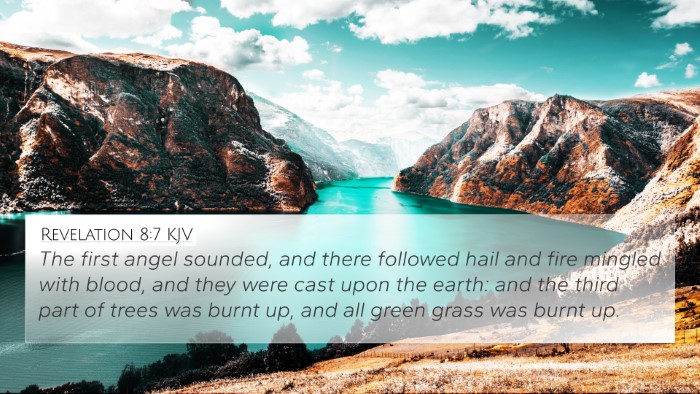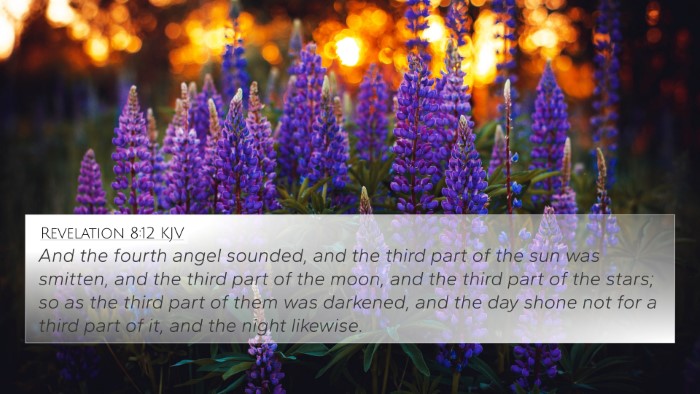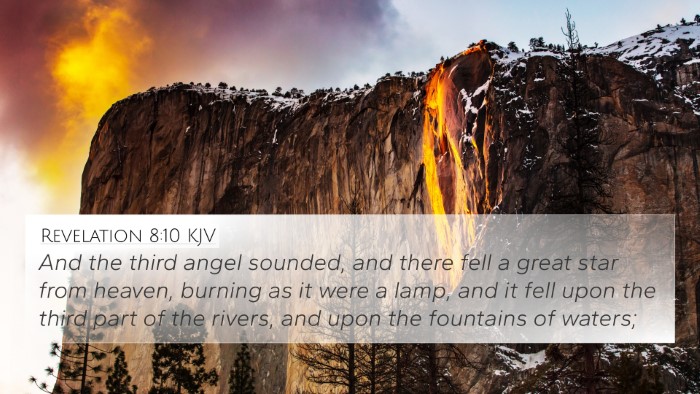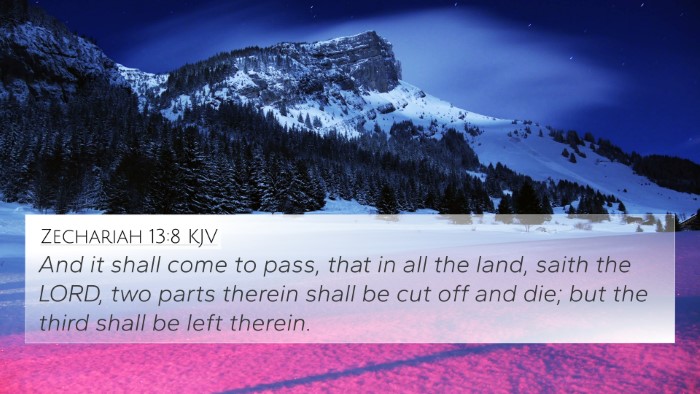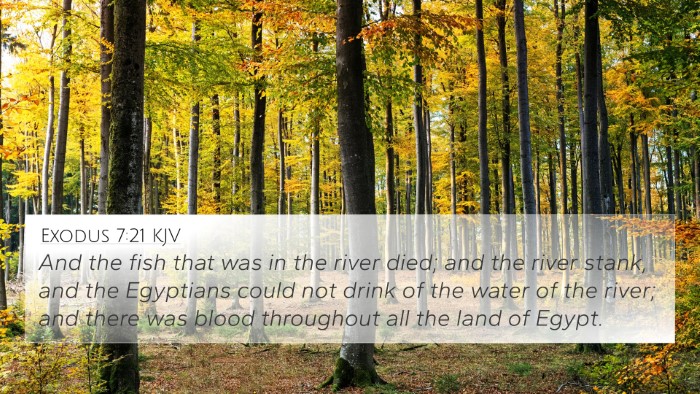Understanding Revelation 8:9
Revelation 8:9 states: “And the third part of the creatures which were in the sea, and had life, died; and the third part of the ships were destroyed.” This verse holds profound implications concerning divine judgment and the consequences of humanity's actions. To glean a deeper understanding, insights from various public domain commentaries provide valuable perspectives.
Matthew Henry's Commentary Insights
Judgment and Destruction: Matthew Henry emphasizes the severity of God’s judgment. He notes that the trumpet judgments serve as a wake-up call to humanity, reminding them of the dire consequences of sin. The destruction of marine life symbolizes a broader spiritual degradation, reflecting how human actions can corrupt God’s creation.
Symbolism of Ships: Ships, in this context, represent the means of commerce and trade. Their destruction signals an economic catastrophe, metaphorically indicating how the loss of spiritual values leads to worldly ruin. The connection between spiritual neglect and material loss is powerfully illustrated.
Albert Barnes' Commentary Insights
Impending Catastrophe: Albert Barnes suggests that this verse portrays an impending catastrophe that is not merely physical but also spiritual. The death of sea creatures suggests that these events cause a rupture in the natural order, akin to the spiritual decay resulting from humanity's rebellion against God.
Third Part Significance: The mention of “a third part” is noted by Barnes to signify a limited yet significant judgment. It demonstrates that God’s patience is running thin and that specific proportions of sin will inevitably attract divine intervention.
Adam Clarke's Commentary Insights
Cosmic Order: Adam Clarke highlights the cosmic implications of this verse. He asserts that the ecological and maritime destruction serves as a reflection of a deranged cosmic order due to mankind's sin against God. Clarke points out that the imagery paints a picture of chaos where once there was order.
Divine Sovereignty: Clarke also discusses the sovereignty of God in orchestrating these judgments. The destruction of both living beings and ships represents the comprehensive effect of God's wrath upon every aspect of life during the last days.
Key Themes and Cross-References
This verse connects to various themes throughout scripture, emphasizing judgment, divine sovereignty, and the loss resulting from sin. Here are some cross-references that enhance our understanding:
- Exodus 7:20-21: The plagues in Egypt demonstrate God's control over nature.
- Isaiah 57:20: Highlights the chaotic state of the wicked, similar to the destruction here.
- Ezekiel 47:10: Relates to the life that springs from God's provision, unlike the lifelessness in Revelation.
- Matthew 24:7: Jesus speaks of calamities, paralleling the judgment themes in Revelation.
- Luke 21:25-26: Prophecies of signs in the heavens and earth, echoing the destruction depicted.
- Romans 8:22: The creation groans due to sin, resonating with the troubled creation in Revelation.
- 2 Peter 3:10: The day of the Lord will bring about the dissolution of creation, akin to the imagery in Revelation.
- Hebrews 12:26-27: The shaking of the heavens and earth aligns with the cosmic disturbances mentioned.
- Revelation 16:3: Further mentions of the sea turning to blood, complementing the theme of divine judgment.
- Revelation 9:18: Further details on the loss of life due to God's judgments.
Conclusion
Revelation 8:9 serves as a critical reminder of the repercussions of human sin and the eventual judgment from God. By examining insights from various esteemed commentaries and recognizing thematic Bible verse connections, we can appreciate the depth of meaning in this passage.
Understanding this verse enhances our biblical studies and encourages us to reflect on our spiritual condition and its potential consequences. Tools for Bible cross-referencing, such as concordances and cross-reference guides, can aid in further exploration of these themes.

